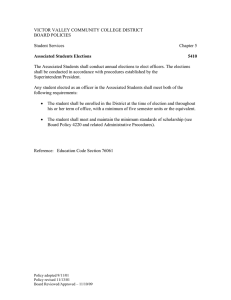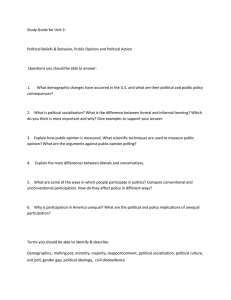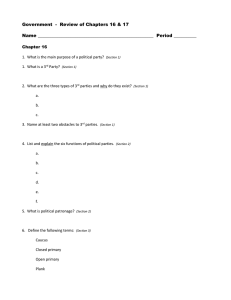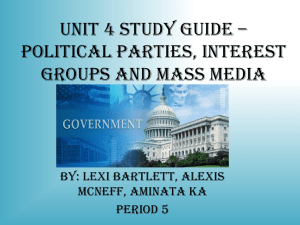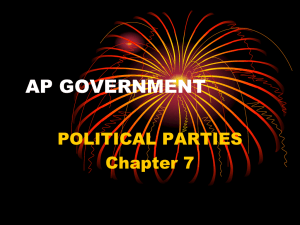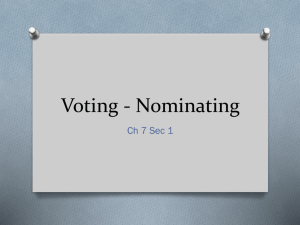Third Parties and City Council Elections Ben Schuerman, Xavier University ‘10 *
advertisement
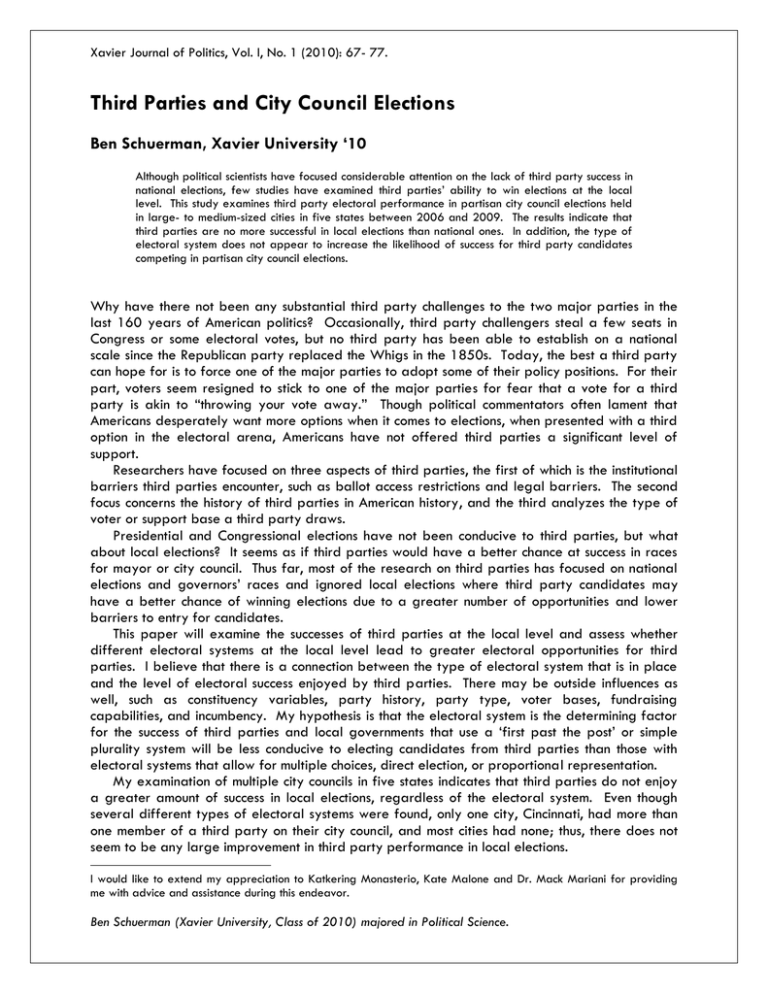
Xavier Journal of Politics, Vol. I, No. 1 (2010): 67- 77. Third Parties and City Council Elections* Ben Schuerman, Xavier University ‘10 Although political scientists have focused considerable attention on the lack of third party success in national elections, few studies have examined third parties‟ ability to win elections at the local level. This study examines third party electoral performance in partisan city council elections held in large- to medium-sized cities in five states between 2006 and 2009. The results indicate that third parties are no more successful in local elections than national ones. In addition, the type of electoral system does not appear to increase the likelihood of success for third party candidates competing in partisan city council elections. Why have there not been any substantial third party challenges to the two major parties in the last 160 years of American politics? Occasionally, third party challengers steal a few seats in Congress or some electoral votes, but no third party has been able to establish on a national scale since the Republican party replaced the Whigs in the 1850s. Today, the best a third party can hope for is to force one of the major parties to adopt some of their policy positions. For their part, voters seem resigned to stick to one of the major parties for fear that a vote for a third party is akin to “throwing your vote away.” Though political commentators often lament that Americans desperately want more options when it comes to elections, when presented with a third option in the electoral arena, Americans have not offered third parties a significant level of support. Researchers have focused on three aspects of third parties, the first of which is the institutional barriers third parties encounter, such as ballot access restrictions and legal barriers. The second focus concerns the history of third parties in American history, and the third analyzes the type of voter or support base a third party draws. Presidential and Congressional elections have not been conducive to third parties, but what about local elections? It seems as if third parties would have a better chance at success in races for mayor or city council. Thus far, most of the research on third parties has focused on national elections and governors‟ races and ignored local elections where third party candidates may have a better chance of winning elections due to a greater number of opportunities and lower barriers to entry for candidates. This paper will examine the successes of third parties at the local level and assess whether different electoral systems at the local level lead to greater electoral opportunities for third parties. I believe that there is a connection between the type of electoral system that is in place and the level of electoral success enjoyed by third parties. There may be outside influences as well, such as constituency variables, party history, party type, voter bases, fundraising capabilities, and incumbency. My hypothesis is that the electoral system is the determining factor for the success of third parties and local governments that use a „first past the post‟ or simple plurality system will be less conducive to electing candidates from third parties than those with electoral systems that allow for multiple choices, direct election, or proportional representation. My examination of multiple city councils in five states indicates that third parties do not enjoy a greater amount of success in local elections, regardless of the electoral system. Even though several different types of electoral systems were found, only one city, Cincinnati, had more than one member of a third party on their city council, and most cities had none; thus, there does not seem to be any large improvement in third party performance in local elections. I would like to extend my appreciation to Katkering Monasterio, Kate Malone and Dr. Mack Mariani for providing me with advice and assistance during this endeavor. Ben Schuerman (Xavier University, Class of 2010) majored in Political Science. XJOP, Vol. I., No. 1 (2010) Third Parties and City Council Elections A Brief History of Third Parties in America Although they have not always been successful, third parties have a long history in American politics. Many third parties formed in the nineteenth and twentieth centuries for a variety of reasons, among them were the causes of abolition, slavery, anti-immigration, anti-industrialization, pro-farmer and labor. Most parties would actually continue where the previous third party had stopped and would simply make small changes in content or focus to their platform, thus attaining the support of the old party's members. In this way, the third parties of the nineteenth and early twentieth century can be viewed as one or two continuous parties. These parties emulated the major parties of their time and created wide-ranging platforms and attempted to gain members and loyalty (Gillespie 1993). At the same time, third parties were also beset by the problems that plague most third parties, such as lack of recognition and limited resources. Moreover, although each of these third parties hoped to bring issues to light or become a major factor in elections, few ever managed to accomplish these goals. In the twentieth century, third parties were largely a tool for individuals to espouse their vision for the country and run for office. These campaigns were less about the party and more about one person. As such, the party did not form issue platforms or retain broad support, especially once their figurehead left the political arena (Rosenstone, Behr, and Lazarus 1996). Similarly, in modern elections, individuals such as Ross Perot or Ralph Nader gained recognition for themselves rather than for their party. Third parties have had very little success in the twentieth century. The greatest period of success for third parties came in congressional and gubernatorial elections from 1850 – 1930, a period viewed as a party-centered era (Gillespie 1993). The 80 years since 1930 have seen only a handful of third party victories in gubernatorial and congressional elections, as well as a few decent efforts by independent presidential candidates. In 1990, the two outside candidates that won gubernatorial races ran similar campaigns. In Alaska, former Governor and Secretary of the Interior Walter J. Hickel ran as a member of the Alaskan Independence Party. Hickel used his large personal fortune in order to wage a successful TV campaign. His campaign was aided by the legitimacy it gained from opposition attacks and the media‟s close coverage of his campaign. Hickel ran mostly on his own values and personal qualities, ignoring his party‟s main issues, thereby emulating the third party figureheads of the earlier twentieth century. In Connecticut, Lowell Weicker used similar methods to win statewide election. Weicker, a Senator for 18 years, formed his own party for the campaign and used his own fortune and financial contacts to legitimize his candidacy. The media and his opponents essentially made him the frontrunner and voters supported his centrist stance, giving him a comfortable victory (Gold 2005). Angus King used similar techniques in 1994 when he financed his own independent campaign for a Maine congressional seat. King ran as an Independent and used his recognition from hosting a public access show about the state government, as well as his own funds, becoming another outside candidate to win in Maine (Bibby and Maisel 2003). Breaking from this mold of outsider campaigns was former professional wrestler Jesse Ventura who successfully ran for governor of Minnesota in 1998. Ventura had high name recognition from wrestling and acting, but no experience in politics beyond serving as mayor of a small Minnesota city. Instead of forming his own party, Ventura joined the Reform party started by Ross Perot. Ventura benefitted in multiple ways from the special nature of Minnesota‟s voting laws. Due to its previous performance, the Reform party qualified for public financing. Additionally, the unique qualities possessed by Ventura facilitated widespread appeal among younger males who saw him as an amicable and competent leader. Ventura effectively used a last minute vote drive to win the election, campaigning throughout the state for the last three days and taking advantage of a Minnesota law which allows for same-day voter registration on election day (Lacy and Monson 2002; Gold 2005; Southwell 2003). Recent elections suggest that access to campaign funding and name recognition are the two most important factors in the success of third party candidates. 69 XJOP, Vol. I., No. 1 (2010) Third Parties and City Council Elections Bernard Sanders‟ victory in the 1990 Vermont Senatorial election is less consequential than the previously mentioned gubernatorial races. Sanders' ran for Senate as an Independent in an essentially two-person race against a widely disliked incumbent. His position in this election could be characterized as a far-left Democratic position, officially running as an Independent with a socialist platform (Endersby and Thomason 1994). More recently, Joseph Lieberman, a Senator from Connecticut, ran for re-election in 2006 and lost the Democratic primary. He then ran as an Independent in the general election, essentially creating his own own party to win the election. Lieberman‟s transition to a third party was not by choice, but a last-minute decision following his loss to challenger Ned Lamont in the Democratic primary. As such, Lieberman‟s victory as a member of a third party was not a reflection of voter desire for a different party or dissatisfaction with the two major parties. Indeed, despite some issues, Lieberman continued to participate in the Senate Democratic Caucus after the election (Healy 2006). A handful of third party candidates have also experienced some measure of success at the presidential level. Table 1 illustrates the history of noteworthy Presidential third party candidates in the United States since 1832. Most notable is Teddy Roosevelt and his 88 electoral votes. In recent elections, three are significant. In 1968, George Wallace knew he could not win the election outright but stated that his goal was to prevent either Nixon or Humphrey from winning a majority of the electoral vote. Wallace could then theoretically bargain with one of them to give them his electoral votes so that the decision would not go the House of Representatives. However, Wallace did not receive enough votes to make this possible (Abramson et al. 1995). Table 1. Results of Third Parties in National Elections Third Party Anti-Masonic Free Soil Whig-American Southern Democrat Constitutional Union Populist Progressive (T. Roosevelt) Socialist Progressive (La Follette) States' Rights Democrat Progressive (H. Wallace) American Independent (G. Wallace) John B. Anderson H. Ross Perot Reform (Perot) Reform (Buchanan) Green (Ralph Nader) Nader* Year 1832 1848 1856 1860 1860 1892 1912 1912 1924 1948 1948 1968 1980 1992 1996 2000 2000 2004 Popular Vote % 7.0 10.1 21.5 18.1 12.6 8.5 27.5 6.0 16.6 2.4 2.4 13.5 7.1 18.9 8.4 0.4 2.7 0.5 Electoral Votes 7 0 8 72 39 22 88 0 13 39 0 46 0 0 0 0 0 0 * All data from Bibby and Maisel, 2003 with exception of 2004 data, which was obtained from the Federal Election Commission, 2004. 70 XJOP, Vol. I., No. 1 (2010) Third Parties and City Council Elections In 1992 Ross Perot was considered a viable candidate in the Presidential election and ultimately won almost 19% of the vote. This vote total was evenly distributed across the country, however, and Perot was unable to parlay his support into any electoral votes. The support Perot received led him to found his own party, the Reform Party, under which he ran for President in 1996 (Abramson et al. 1995). The Reform Party could not hold itself together without Perot‟s presence, however, and it self-destructed during the 2000 election, allowing the Green Party and Ralph Nader to assume the role of America's leading third party (Bibby and Maisel 2003). The Nader campaign is best known for its‟ role in the outcome of the 2000 election. Nader originally ran in 2000 because of his belief that no difference existed between the two major parties. Although some studies have shown that Nader did steal votes away from former Vice President Al Gore in the election (Whitmore 2008), other studies indicate that the groups Nader drew to his campaign were people who would not have voted for Democrats regardless of the circumstances (Allen and Brox 2005). Nevertheless it is still widely believed that he stole enough votes from Gore to affect outcomes in multiple states (Bibby and Maisel 2003). Nader‟s role in this election left third parties with a particular stigma, one that did not exist when Perot ran in 1992 and 1996. If third party candidates barely ever succeed, why do they persist in running? One of the most common reasons for a person to pursue office as a third party candidate is when there is a belief that little difference exists with regards to the ideologies of the two major candidates. Some third party candidates pursue office because of a strong belief that Republicans and Democrats are too close together or too far apart to provide adequate coverage of the entire spectrum of political viewpoints. Another potential reason for running is when it appears that one of the major two parties has deteriorated, leaving them vulnerable or weak (Rosenstone, Behr, and Lazarus 1996). The type of third party that emerges depends on whether the election is political or ideological in nature. If there is a lack of complete coverage of the political spectrum a shortlived party might attempt to enter the race and fill the perceived void. Short-lived parties are third parties that come into existence through a form of protest or as a splinter from one of the major parties. These parties do not last long because the major parties eventually shift their stance on policies or bring in different candidates to fill the void in the election themselves. If the void is more ideological, a doctrinal party could attempt to win the election. Doctrinal parties are parties that focus on one or two issues that are most important to them and work towards achieving that one goal. Doctrinal parties have less success than short-lived parties due to the narrower appeal of their issue platforms. The third possible form that could run is a local or nonnational third party, although this is less likely when the election is focused on the state or local level (Gillespie 1993). A candidate may also run as a third party candidate because they want to establish themselves as a force for an issue or because they want to make their voice be heard. The recognition from the election can pay dividends for the candidate later, either in the form of policy recognition or employment. For any of these possibilities to happen, the barriers to entry in the election must also be low enough so that the candidate can actually participate in the election without having to overcome great legal obstacles (Lem and Dowling 2006). Why do voters vote for these candidates if they hardly ever succeed? Many third party voters are simply people who have consistently voted for third parties as a result of alienation from one of the major parties or as a form of protest against the entire system. These kinds of voters do not believe the current party system represents them or their interests very well. This viewpoint is prevalent among young voters who often either choose between not voting at all or casting their vote for a third party candidate as a protest (Allen and Brox 2005; Southwell 2003). Some voters also vote this way simply because the candidate appeals to them and to their ideals, even if voting for them might seem as if they are throwing their vote away (Simmons and Simmons 2006). 71 XJOP, Vol. I., No. 1 (2010) Third Parties and City Council Elections Electoral Obstacles to Third Parties The United States uses an electoral system that strengthens the two major parties. Due to its use of the single ballot plurality system, the United States is the prime example of Duverger‟s law, which states that plurality-based electoral systems favor the existence of only two parties (Duverger 1963). Since elections in the United States do not have any kind of run-off, the individual who gets the most votes, regardless of whether it is a majority or not, wins. A pluralitybased system maintains the power structure of the two major parties. Third parties are not able to gain a plurality in many locations and therefore cannot get electoral votes. A secondary effect of the plurality-based system is the effect it has on voters. The knowledge that a third party candidate has very little chance of victory makes it more likely that voters will practice strategic voting and vote for the best major party candidate (Abramson et al. 1995). The decision to strategically vote instead of voting for the candidate that is most appealing reinforces the idea that third party candidates cannot win. Rather than voting for their favored candidate, many voters choose to vote strategically though and become disillusioned with the electoral process. Third party failure is also a result of how ballots are constructed and how parties or individuals obtain a spot on the ballot. In 1896 many states began to switch to the Australian style ballot. The Australian style ballot is an official ballot that is printed by the state and is only available on Election Day when an individual goes to vote. Australian ballots replaced ballots that were printed by parties and were given to individuals beforehand. The Australian ballots helped the major parties control who was on the ballot by having the state print the only ballots accepted at the polls, instead of letting the parties print their own ballots (Walker 2006). Whichever party was in control of the ballot process controlled which parties were on the ballot. The Australian ballot also helped citizens vote for different candidates or split their tickets, something they could not easily do prior to the utilization of this technique (Rosenstone, Behr, and Lazarus 1996). The adoption of the Australian ballot forced third parties to overcome additional obstacles to be placed onto ballots. One major obstacle was state-level petition requirements, which established the number of signatures a candidate would need in order to be placed on the ballot. David R. Shock‟s (2008) study exemplifies that the requirements for House elections are often the most difficult to attain, as these levels are much higher in comparison to requirements for Senatorial or Presidential candidacies. This could indicate that the major parties are most afraid of minor parties in smaller, district-based elections rather than statewide elections. Shock also showed that election requirements vary considerably between states (Shock 2008). Other studies contend that electoral barriers are less important than major parties' adaption of third party platforms and ideas, especially with regards to parties on the far left (Hirano and Snyder, Jr. 2007). Third parties have implemented various methods in order to circumvent these electoral obstacles. One particular method third parties have used is fusion politics, which is the process by which a candidate can run as the candidate for multiple parties and then have those votes added together for their final total. This system creates alliances between third parties and the major parties in order to best use their resources and voter turnout. The minor parties can decide to run their own candidate or they can support a major candidate, depending on whether they believe that person adequately represents them and their issues. In this way, a vote for a third party could mean more than the otherwise futile effort for protest. Republicans especially attempted to prevent this type of situation by using tools like the Australian ballot to eliminate them from many areas (Argersinger 1977). Fusion politics is practiced in New York State, where the two major parties vie for the support of third-party organizations such as the Working Family party. The history of third parties demonstrates that third parties have and likely will continue to struggle to win elections on the national level. However, as previously stated, most of this research focuses on presidential, congressional and gubernatorial elections; few researchers have focused 72 XJOP, Vol. I., No. 1 (2010) Third Parties and City Council Elections attention on third party success at the local level. Local elections have more variety in the types of election systems and institutional structures that could create advantages for third parties. Local elections are a logical place to analyze whether certain types of systems are particularly beneficial to third parties. Research Design There are primarily two types of local elections: mayoral and city council. City council races offer more variety in election systems and institutional structure than mayoral races, creating better opportunities to study the viability of third party candidates. The objective of this study is to examine the level of third party success in city council elections and the relationship between electoral systems and third party victories. This study will assess third party success in 28 cities from Illinois, Indiana, Michigan, Ohio, and Wisconsin with populations over 100,000 that hold partisan elections for city council. The data will be derived from recent city council elections in these cities, ranging from 2006 to 2009. From this data, it will be possible to infer what types of electoral systems best allow for third party candidates to achieve electoral success. Illinois, Indiana, Michigan, Ohio, and Wisconsin were chosen for this study because they are collectively identified as the East North Central States by the U.S. Census Bureau (United States of America 2009)–focusing on one region of the country helps to control for the potential impact of political culture on the development of third parties. In addition, previous research suggests that these five states share similar cultural and political characteristics. According the categorization of political culture originally laid out by Daniel Elazar and later modified by Charles Johnson, the states from the East North Central area share the characteristics of an individualistic state. Elazar‟s categories were based on states‟ religious and ethnic characteristics, as well as the patterns of group movement across the United States. While Elazar‟s system is generally accepted, Johnson identified limitations inherent within Elazar‟s classifications. For example, while Elazar described Michigan and Wisconsin as moralistic states, Johnson‟s discriminant analysis placed them in the individualistic category. Johnson accredited these differences to the presence of certain religions, such as Roman Catholicism, and the influence these faiths had on state political systems. Johnson‟s analysis ultimately shows that a state‟s political culture correlates with variables like government activities, popular participation in elections, and party competition. There was no correlation between political culture and the importance of political parties (Johnson 1976). However, Johnson‟s results show that these states are likely to share characteristics that could otherwise act as intervening or conditional variables and affect the data. Choosing states with similar political cultures will help ensure other variables such as political participation and government actions and activities are similar between states and communities. Eleven cities met the criteria for inclusion in this study. A review of the U.S. Census Bureau‟s 2008 population estimates indicates that 28 cities had populations above 100,000 within the five states selected for this study. The full list of 28 cities and their characteristics can be found in Table 2. Of the 28 cities, 27 had a city council government of some form. Cities with more than 100,000 people were chosen for this study in order to create a sample size that was representative and allowed for examination of cities that are large enough to support third parties. An examination of election results and city council websites indicates that 11 of the 28 cities had either partisan elections or parties that clearly conveyed their support for candidates through a formal endorsement process, either through newspaper publications or endorsements on party websites. City council elections are the focus of this study because there is considerable variability in the electoral systems used from city to city. Researchers have examined national elections in depth for their effect and opportunities third parties have had on them, but there has been little analysis of third party success in city councils. City councils are ideal because, in comparison to mayoral elections, the barriers to entry are relatively low and there are a larger number of electoral 73 XJOP, Vol. I., No. 1 (2010) Third Parties and City Council Elections opportunities for third party candidates to be elected. The variety of electoral systems provides the opportunity for comparison between systems and the opportunities each type of system presents to third party candidates. By examining the level of success for parties in different electoral contexts, it is possible to see what institutional arrangements are most conducive to the election of third party candidates. City council elections are also a good choice for this type of analysis because city council positions generally have similar responsibilities, whereas the role and power of city mayors can vary substantially from city to city. Mayoral elections are also too similar, in both style and electoral system, to be a good test of third party success. Table 2: Overview of Cities and Electoral Systems City Third City Population Council Election Type Partisan Election Rep. Dem. Party Chicago, IL 2,853,114 Yes District No/with support 1 49 0 Aurora, IL 171,782 Yes District + At Large No ----- --------Rockford, IL 157,272 Yes District Yes 6 7 1 Joliet, IL 146,125 Yes District + At Large No ----- --------Naperville, IL 143,117 Yes At Large No ----- --------Springfield, IL 117,352 Yes District No ----- --------Peoria, IL 114,114 Yes District + At Large No ----- --------Elgin, IL 106,330 Yes At Large No ----- --------Indianapolis, IN 798,382 Yes District + At Large Yes 16 13 0 Ft. Wayne, IN 251,951 Yes District + At Large Yes 5 4 0 Evansville, IN 116,309 Yes District + At Large Yes 1 8 0 South Bend, IN 103,807 Yes District + At Large Yes 1 8 0 Detroit, MI 912,062 Yes At Large No ----- --------Grand Rapids, MI 193,396 No ------------ --------Warren, MI 133,939 Yes At Large No ----- --------Sterling Heights, MI 127,160 Yes At Large No ----- --------Ann Arbor, MI 114,386 Yes District Yes 0 10 0 Lansing, MI 113,968 Yes District + At Large No ----- --------Flint, MI 112,900 Yes District No ----- --------Columbus, OH 754,885 Yes At Large Yes 0 7 0 Cleveland, OH 433,748 Yes District No ----- --------Cincinnati, OH 333,336 Yes At Large No/with support 3 3 3 Toledo, OH 293,201 Yes District + At Large No ----- --------Akron, OH 207,510 Yes District Yes 0 10 0 Dayton, OH 154,200 Yes At Large No/with support 0 4 0 Milwaukee, WI 604,477 Yes District No ----- --------Madison, WI 231,916 Yes District No ----- --------Green Bay, WI 101,025 Yes District No ----- --------Note: Madison‟s city council has two members who received support from the Wisconsin Green party. The party affiliations of the other members of the Madison Common Council could not be checked or verified, so the results were not used in the final analysis. Third party success will be measured by whether or not third party candidates won a seat in the most recent election. Victory is used as the measure of success because in an election the ultimate barometer of success is whether or not the candidate won, not the percentage of the vote the candidate received. Election data will be collected through cities' boards of election, local newspapers, and directly from the city councils via their websites. The ability of different electoral systems to create opportunities for third party candidates will be assessed by comparing the success of third party candidates across different electoral systems. I hypothesize that non-pluralistic electoral systems will be the most conducive to third party success on the local level. This idea is based on my belief that non-plurality systems are not as susceptible to Duverger‟s law (Argersinger 1977). This hypothesis is also founded in the ability of multiple parties to exist and be elected in the elections of other countries. Many European 74 XJOP, Vol. I., No. 1 (2010) Third Parties and City Council Elections countries are able to support more than two parties due to different styles of election (Calvo 2009). Other variables may retain influence as well, such as whether third parties have had a history in certain cities, like in Wisconsin (Bibby and Maisel 2003), or if third parties have equal or lesser advantages at fundraising or creating voter bases. Third party success is measured by the percentage of third party candidates that won a seat on city council in the most recent election. The success of third parties in different electoral contexts will also be examined to assess which type of electoral system is most conductive to the election of third party candidates. I believe that the races that use an at-large election or some combination of at-large and district based plurality will be more conducive to third parties than a system that uses a straight district-based plurality. Analysis Of the 28 cities that were considered for this study, only 11 met the required criteria (see Table 3). The study also included three cities that did not have partisan elections, but had candidates clearly supported by a party, shown through publications in local news, their own campaign information, or through declarations by independent candidates. Table 3. Third Party Presence in City Council Elections City Council Partisan Election Type Rep Dem Indianapolis Ft. Wayne Evansville South Bend Rockford Ann Arbor Akron Chicago Cincinnati Dayton Columbus yes yes yes yes yes yes yes yes yes yes yes yes yes yes yes yes yes yes no/support no/support no/support yes District + at large District + at large District + at large District + at large Districts Districts Districts Districts At Large At Large At Large 16 5 1 1 6 0 0 1 3 0 0 13 4 8 8 7 10 10 49 3 4 7 Third Party 0 0 0 0 1 0 0 0 3 0 0 Third Party Pct 0% 0% 0% 0% 7% 0% 0% 0% 33% 0% 0% My hypothesis was that local elections would allow third parties to be more successful than they are on the national level. The (limited) data presented here does not support this hypothesis. Of the eleven councils included in the study, only two had third party representation. Of the 160 council positions examined here, only four were filled by members of a third party. In comparing third-party success across electoral systems, Table 4 (below) indicates that one city that used an at-large system had third party members on its city council and one that used only a district based plurality system also had third party members on its city council. The only difference between these two cities is that the city that used an at large system, Cincinnati, had three members from third parties while the city that used the district-based plurality, Rockford, had just one third-party member. Table 4. Third Parties on City Council by Electoral System At Large District + At Large Districts Total No Third Party Third Party Presence Presence 2 1 4 0 3 1 9 2 75 XJOP, Vol. I., No. 1 (2010) Third Parties and City Council Elections There is not yet enough data to draw any firm conclusions, but it may be that an at large system creates better opportunities for third party candidates, since the larger number of opportunities to attain votes and a potentially larger pool of voters to vote for the candidates. Clearly, a larger, nationwide sample over multiple elections is needed to assess whether at-large systems provide third party candidates with advantages or whether there is something unique to the politics of Cincinnati, OH. Conclusion The limited number of cities examined here makes it impossible to draw any firm conclusions with regard to my hypothesis that local elections are more conducive to third party success. Of the eleven cities that qualified for the study, only two maintained third party members on their city councils. If the findings presented here are replicated in a broader, nationwide study, it would provide additional evidence that the American political system is not conducive to third parties. Moreover, given the variety of electoral systems at the city council level, the failure of third parties to win elections to city council would suggest that the failure of third parties has less to do with electoral systems than other factors. As there were not many third party members who won election to city council, there seems to be no evidence that one electoral system is better for third parties to be elected. Of the two cities that did have members of third parties, Rockford used a district based system and had one third party member, while Cincinnati used an at large system that allowed for the election of three third party candidates. This could be interpreted as an advantage for those who use an at large system, but there is not enough data to support that claim. It is worth noting that, of the members of the Cincinnati City Council who were not of the major two parties, two were members of a local party and had previous exposure on the local political scene and the third was an independent. This also indicates that name recognition and other political factors tend to be more significant than the type of electoral system used. It is important to acknowledge, once again, the limitations of this study, most notably the fact that the sample size was small. A larger sample size of thirty or more could provide for greater confidence in the results. The study was also limited to states in the East North Central region; a different region of the country or including other areas to the existing data used may also affect the results and reveal third party prominence in other sections of the country. Adding other states to the data would introduce the problem of political culture to the study, but this could be addressed by adding a regional control variable to the analysis, or by comparing results region by region. One problem with the current data that may have affected the results of the study lies with the cities that hold non-partisan elections. Most of the cities in the region that had over 100,000 people did not qualify for the study because they did not have partisan elections. While partisan elections were examined in this study as it was constructed, it is likely that members of third parties have a better chance when parties are not a major part of campaigns or are not printed on the ballots. Nonpartisan elections rose to prominence in the late 19 th century and 20th century, used as a tool to dismantle party machines in local governments or to inhibit the ability of socialist parties to gain office (Bibby and Maisel 2003). There could be other members of third parties who hold seats on city council, but this affiliation or support cannot be found by solely examining ballot results or through the city council‟s public informational resources. Further research on this topic could extend this study by adding additional cities, either by including non-partisan elections or by lowering the population threshold to a number such as 75,000 or 50,000 people. Another alteration or further conduction of this study could be an examination of the city councils of a different region of the country. Future researchers could also work to identify the party registration of elected members of nonpartisan city councils; from this data it would be possible to ascertain the presence of third parties in cities that do not have partisan elections. There are also many other potential relationships that could be explored in the 76 XJOP, Vol. I., No. 1 (2010) Third Parties and City Council Elections area of local third parties, like the relationship between third parties and population and the prospects of third party success when local candidates run for higher office. Because there have been few studies on the local effect of third parties, there are many opportunities for further research. Works Cited Abramson, Paul R., John H. Aldrich, Phil Paolino, and David W. Rhode. 1995. “Third-Party and Independent Candidates in American Politics: Wallace, Anderson, and Perot.” Political Science Quarterly 110, 3: 349 – 367. Allen, Neal and Brian J. Brox. 2005. “The Roots of Third Party Voting.” Party Politics 11, 5: 623637. Argersinger, Peter H. 1977. “„A Place on the Ballot‟: Fusion Politics and Antifusion Laws.” American Historical Review 85: 287 – 306. Calvo, Ernesto. 2009. “The Competitive Road to Proportional Representation: Partisan Biases and Electoral Regime Change Under Increasing Party Competition.” World Politics 61, 2: 254 – 295. Duverger, Maurice. 1963. “Political Parties: Their Organization and Activity in the Modern State.” Trans. Barbara North and Robert North. New York, NY: Wiley. Endersby, James W. and David W. Thomason. 1994. “Spotlight on Vermont: Third Party Success in the 1990 Congressional Election.” Social Science Journal 31, 3. Gillespie, David J. 1993. “Politics at the Periphery: Third Parties in Two-Party America.” Columbia, SC: University of South Carolina Press. Gold, Howard J. 2005. “Explaining third-party success in gubernatorial elections: The cases of Alaska, Connecticut, Maine and Minnesota.” The Social Science Journal 42: 523 – 540. Healy,Patrick. 2006. "The Connecticut Senate Race." The New York Times. Web. http://www.nytimes.com/ref/washington/raceprofile_CONNECTICUTSENATE.html (viewed Nov. 2009). Hirano, Shigeo. 2008. “Third Parties, Elections, and Roll-Call Votes: The Populist Party and the Late Nineteenth-Century U.S. Congress.” Legislative Studies Quarterly 33, 1:131 – 160. Hirano, Shigeo and James M. Snyder, Jr. 2007. “The Decline of Third-Party Voting in the United States.” The Journal of Politics 69, 1: 1-16. Johnson, Charles A. 1976. “Political Culture in American States: Elazar‟s Formulation Examined.” American Journal of Political Science, 20, 3: 491 – 509. Lacy, Dean and Quin Monson. 2002. “The Origins and Impact of Votes for Third-party Candidates: A Case Study of the 1998 Minnesota Gubernatorial Election.” Political Research Quarterly 55, 2: 409 – 437. 77 XJOP, Vol. I., No. 1 (2010) Third Parties and City Council Elections Lem, Steve B. and Conor M. Dowling. 2006. “Picking Their Spots: Minor Party Candidates in Gubernatorial Elections.” Political Research Quarterly 59, 3: 471 – 480. Rosenstone, Steven J., Roy L. Behr, and Edward H. Lazarus. 1996. “Third Parties in America: citizen response to major party failure.” Princeton, NJ: Princeton University Press. Shock, David R. 2008. “Securing a line on the ballot: Measuring and explaining the restrictiveness of ballot access laws for non-major party candidates in the United States.” The Social Science Journal 45: 48 – 60. Simmons, Solon J. and James R. Simmons. 2006 “If it Weren‟t for Those ?*!&*@!* Nader Voters we Wouldn‟t Be in This Mess: The Social Determinants of the Nader Vote and the Constraints on Political Choice.” New Political Science 28, 2: 229 – 244. Southwell, Priscilla Lewis. 2003 “The politics of alienation: nonvoting and support for third-party candidates among 18-30-year-olds.” Social Science Journal 40: 99-107. United States FederalElection Commission. 2004 Election Results. Web. pubrec/fe2004/tables.pdf (viewed Nov. 2009). http://www.fec.gov/ United States of America. United States Census Bureau. Population Division. Population Estimates. U.S. Census Bureau, 1 July 2009. Web. http://www.census.gov/popest/cities/SUBEST2008.html (viewed November 8, 2009). Walker, Lee Demetrius. 2006 “The Ballot As A Party-System Switch.” Party Politics 11, 2: 217 – 241. Whitmore, Andy. 2008. “Schism on the Left: the Motivations and Impact of Ralph Nader‟s Candidacy.” The Political Quarterly 79, 4:556 – 559. 78

